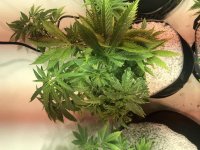cancareent
Member
Hey Guys, first time in coco... having some issues any help would be good.
Specs -
Strain GSC
RH- 55-65%
Temps - light temp 75-80
night temp 69-73
12 gallon pots
Let me know if further info is needed
Specs -
Strain GSC
RH- 55-65%
Temps - light temp 75-80
night temp 69-73
12 gallon pots
Let me know if further info is needed






